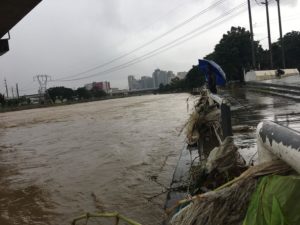
Metro Manila’s near “Ondoy” experience over the weekend shows just how difficult it has been for the government to solve the flood problem despite trillions of pesos in taxpayer’s money spent on various recommendations made by flood control experts in the past years.
The Department of Public Works and Highways-National Capital Region (DPWH-NCR) office was tasked to build big ticket flood mitigating projects. These included the P609-million Mandaluyong main drainage area project to prevent flooding in Maysilo, San Juan River and Quezon City; the P203-million Manila City Hall-Intramuros flood drainage project; the P600-million Blumentritt flood interceptor project in Manila and the P296-million Manila Bay seawall project.
According to DPWH-NCR Director Melvin Navarro, the projects are done except for the Blumentritt flood interceptor which is expected to start operating next year following the installation of its “modern pumping station.”
The Metropolitan Manila Development Authority (MMDA), on the other hand, is tasked to reduce flooding by 10 percent, with floodwaters receding within 40 minutes. It manages the 57 pumping stations in flood-prone areas amid “esteros” that are heavily silted and full of garbage.
In 2017, the Commission on Audit (COA) noted that the MMDA did not finish 47 out of 68 flood control projects, thus wasting P335 million in taxpayer’s money. The COA cited frequent changes in the agency’s management and the composition of its bids and awards committee. However, newly appointed MMDA General Manager Bong Garcia said that after a few “adjustments,” everything was on track for 2019.
Hopes are high though for the ongoing “$500-million (P26.5 billion) Metro Manila flood control management project” financed by a loan from the World Bank and Asian Infrastructure Investment Bank of China. To be finished in 2024, the project will have 20 new pumping stations. It will also modernize 37 others on top of relocating informal settlers residing along major waterways.
But it’s a different story in Marikina City and Cainta, Rizal, where gravity, not pumping stations, is the main issue. When the water level in Laguna de Bay rises, the Marikina River also swells. From a recent interview, San Miguel Corp. president and COO, Ramon Ang, said that Laguna de Bay used to have a depth of 22 meters, but because of garbage and other waste materials, this went down to 3.5 meters.
The problem could have been mitigated earlier if former President Noynoy Aquino did not cancel the P18-billion Laguna Lake Rehabilitation Project of Belgian dredging company, Baggerwerken Decloedt En Zoon (BDZ), in 2011. BDZ was behind the Pasig River Rehabilitation Commission project that we see in Guadalupe, Makati.
The firm was supposed to dredge Laguna de Bay and the Napindan Channel so floodwaters could flow out easily and faster. The dredged materials were to be used to reclaim areas in Taytay, Angono and San Pedro for water treatment facilities just like in Europe. But Noynoy called the contract fraudulent and canceled it. In January 2017, the World Bank’s International Centre for Settlement of Investment Disputes called the decision illegal and unfair and ordered the government to pay a penalty of P800 million.
If you have comments, please e-mail jakejm2005@yahoo.com